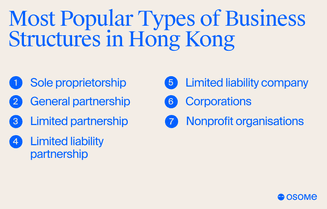Top 7 Types of Business Structures in Hong Kong
- Published: 15 March 2024
- 11 min read
- Starting a Company


Gabi Bellairs-Lombard
Business Writer
Gabi creates content that inspires. She's spent her career writing compelling website copy, and now she specialises in product marketing copy. As the voice of our products and features, Gabi makes complex business finance and accounting topics easy to understand. Her top priority is ensuring that her words impact and inspire her readers.
Knowing about the different types of business structures in Hong Kong is research every business owner needs to conduct to set themselves up for success. This concise guide details seven key structures, from sole proprietorship to nonprofit organisation, weighing up their respective legal liabilities and tax implications to help you identify which suits your business needs.
Key Takeaways
- Choosing the right business structure affects personal liability, tax implications, ease of start-up, and administrative requirements. Hong Kong offers several options, including sole proprietorships, limited liability partnerships, LLCs, and corporations.
- Different types of businesses have unique advantages and drawbacks, such as pass-through taxation for sole proprietorships and partnerships versus corporate taxation for corporations, affecting financial management and risk exposure.
- The growth potential, funding needs, and the business owner’s risk tolerance should guide the choice of company structure, with the possibility of restructuring as the business evolves to better suit changing goals, scalability, and liability concerns.
Understanding Business Structures
In the world of business, the structure of your business is the foundation that supports everything from your entrepreneurial vision to the daily operations. As a pivotal choice with far-reaching impact, a business structure influences your financial landscape, your risk exposure, and even how you navigate your business through the sea of market regulations.
Understanding the differences between the types of businesses can help you leverage unique benefits while avoiding drawbacks, whether you're a solo entrepreneur or part of a thriving business entity. It’s essential to consider each as a separate business entity:
- Sole proprietorships
- Partnerships
- Limited liability company (LLC)
- Corporations
Looking for guidance on choosing the appropriate company structure? Our experts can help you navigate these options and find the best fit for your business goals. Contact us today to get assistance with registering your company and selecting the right business structure!

Key factors to consider
Several crucial factors influence your decision on a business structure:
- Your comfort level with personal liability
- The tax consequences inherent in each structure
- The simplicity of initiating your business venture
- The administrative challenges you must overcome
While a sole proprietorship may offer a simple path with less bureaucracy, it also exposes your personal assets to liability. On the other hand, individual entrepreneurs may find the tax system more lenient, as sole proprietorships can be included in personal tax returns, albeit with self-employment taxes.
And while corporations stand strong against liability, they demand a higher toll in legal and administrative obligations. There are several pros and cons to consider when researching the types of businesses for you to choose from for your next venture.
Common business structure terminology
As you explore the intricacies of business structures, familiarising yourself with its terminology is vital. For example:
- Limited liability: a lifeline that keeps your personal assets safely ashore, away from the company’s stormy debts and obligations— a hallmark of corporations and LLCs.
- Pass-through taxation: a channel that allows business profits to flow directly to your personal tax return, avoiding the treacherous whirlpool of double taxation that entities like C corporations face.
7 Most Popular Types of Business Structures
Hong Kong’s business landscape is dotted with diverse structures, each with its distinct blueprint. Entrepreneurs can select from the following popular structures:
- Sole proprietorship
- General partnership
- Limited partnership
- Limited liability partnership
- Limited liability company (LLC)
- Corporations
- Nonprofit organisations
Familiarising yourself with these structures of business ownership will help you choose a business form that aligns with your venture’s values and goals.

1. Sole proprietorship
For the daring entrepreneur, the sole proprietorship provides simplicity and absolute control over your business domain — characteristics many new small businesses are after when starting. It’s a vessel that responds to the single hand without needing to consult a board of directors — a perfect match for those who prefer to navigate independently and claim all income as their personal income. However, this freedom comes with the risk of unlimited liability, where personal and business assets are at risk. Despite this, most startups accept the personal liability associated with being a sole trader. Additionally, this is a common choice for those looking to set up an online business.
However, there are drawbacks to this kind of structure. It's difficult to raise money since you can't sell stock, and banks are reluctant to approve loans. Although a sole proprietorship is vulnerable, it can be dissolved easily for a graceful exit.
2. General partnership
A general partnership is like a shared journey where partners are equally responsible and personally liable for managing and guiding the business. This partnership's financial obligations tie personal assets to the business's fate. This is a business owned by two or more people, as the name suggests.
Pass-through taxation is a positive aspect of a business partnership. This means that the gains and losses of the partnership are directly reflected in the partners' personal tax returns. This helps avoid complications related to corporate tax and personal income tax for each general partner. So, it's a silver lining amidst all the challenges. Compared to other types of businesses, partnerships offer more flexibility but also have greater risk exposure.
3. Limited partnership (LP)
The limited partnership, or LP, combines limited and general partners, providing limited liability for the former and complete exposure for the latter. This vessel involves two or more people and has at least one general partner. LP allows limited partners to invest without navigating the business directly, safeguarding them from the storms of unlimited liability.
However, the general partner is responsible for the management and debts incurred by the LP. A limited partnership is a common choice for small businesses starting out.
4. Limited liability partnership (LLP)
The Limited Liability Partnership, or LLP, appeals to professionals seeking legal protections from personal liability without forgoing the benefit of pass-through taxation. In this alliance, partners are shielded from the financial misadventures of their cohorts, and the LLP structure is particularly favoured among licensed professionals such as lawyers and accountants.
Partners in limited liability partnerships are personally liable only for their own conduct and not for the conduct of other partners or the debts and damages of the business.
5. Limited liability company (LLC)
The Limited Liability Company, or LLC, blends the limited liability of a corporation with the flexibility and tax benefits of a partnership, and exists as its own legal entity. Limited liability companies allow profits to cascade into personal income without the burden of corporate taxation and require fewer formalities than their corporate counterparts, making them an attractive option for entrepreneurs.
Though registering an LLC involves naming protocols and appointing a legal agent, it offers a structure that can be adapted to your management style. Uniquely, a limited liability company can have a single shareholder who can also act as the sole director. This flexibility makes it a popular choice for solo entrepreneurs seeking liability protection and operational control.
6. Corporations
Corporations provide robust protection against personal liability and a powerful platform for capital-raising through stock issuance. Incorporating this type of business, a for-profit corporation, releases owners of the financial liability of the business obligations, and it is a separate legal entity created by shareholders. They come in various forms, including C corporations that can issue multiple classes of stock and have the potential to go public, albeit at the cost of facing double taxation on earnings. Because they can do this, however, C corps have an advantage when it's time to raise money compared to other business entities — they are more attractive to potential investors.
S corporation s, on the other hand, avoid this by:
- Imposing restrictions on the number of shareholders and stock classes
- Filing with the Inland Revenue Department to obtain S corp status
- Allowing profits to pass directly to shareholders without being subject to corporate tax rates
Lastly, benefit corporations differ from C corporations in purpose, accountability, and transparency but are taxed similarly. Benefit corporations are built on both mission and profit, but shareholders are responsible for ensuring that companies provide a benefit to the public beyond just financial gain. A benefit corporation is not the same as a not-for-profit organisation or other business types.
7. Nonprofit organisation
Nonprofit organisations embark on a noble path, prioritising charitable, educational, or social missions over profit-seeking endeavours. These entities are granted tax-exempt status, provided they adhere to stringent rules regarding their use of profits and ensure that all proceeds are reinvested back into their altruistic objectives.
While not all nonprofits must apply for tax-exempt status, those that do, like 501(c)(3) corporations, are spared from federal income tax, allowing them to focus their resources on the greater good.
Business Structures and Taxes
The tax implications of different company structures in Hong Kong vary considerably. It is crucial to understand the tax implications for different types of businesses. This includes the pass-through taxation that sole proprietorships and partnerships enjoy, the corporate taxation that C corporations face, and the tax exemptions available to non-profit organisations. This understanding will help you make informed business decisions and optimise your venture's financial efficiency.
Taxation for sole proprietorships and partnerships
Sole proprietorships and partnerships sail under the flag of pass-through taxation, where the business’s financial currents flow directly onto the owners' or partners' personal tax returns. This can be advantageous for sole proprietors, enabling them to comply with tax obligations by using their personal marginal rates, which may be lower than corporate rates.
Partnerships must keep a detailed log in Schedule K-1 for each partner and submit an informational Form 1065 to the Internal Revenue Service (IRS), outlining each partner’s share of the financial voyage while enjoying the same pass-through benefits.
Corporate taxation
C corporations fall under the unique tax system of corporate taxation, where corporations pay income tax on their profits, which are taxed twice—first at the corporate level and then at the individual level when distributed as dividends. However, the Tax Cuts and Jobs Act of 2017, which amended the Internal Revenue Code, has standardised the federal corporate tax rate to a flat 21%, streamlining the tax landscape for these entities.
Meanwhile, S corporations avoid double taxation by limiting shareholders and passing profits directly to them, validated by the IRS through S corp status.
Nonprofit tax exemptions
Nonprofit organisations in Hong Kong can claim tax-exempt status, enabling them to devote all their resources to their mission without the burden of federal income tax obligations. However, obtaining this tax status requires a separate application to the IRS beyond the state registration process.
These organisations, especially 501(c)(3) corporations, are shielded from the storms of income tax, enabling them to direct all profits back into their cause. Churches and religious groups find themselves in a unique position, often exempt without the need to navigate the application process.
Choosing the Right Business Structure for Your Needs
Choosing the appropriate business structure is like selecting a ship for your entrepreneurial journey—a decision that should mirror your scaling vision, risk tolerance, and the essence of your venture. Whether you’re charting a course for a small-scale endeavour or a larger enterprise, considering a structure that can accommodate anticipated growth, such as an LLC or corporation, is paramount.

Assessing your liability and risk tolerance
Understanding your financial situation and personal resilience is crucial when assessing your liability and risk tolerance. Financial advisors and risk tolerance quizzes can provide insight into your comfort level with potential business risks, but they should not be the sole navigational tools relied upon.
Entrepreneurs must balance their business plan with the high-risk environment of startup investments, preparing for both success and potential challenges.
Evaluating growth potential and funding needs
Evaluating your venture’s growth potential and funding needs requires a careful look at the nature and scale of your business, ensuring that the chosen structure can scale with your ambitions. For businesses with a vision for a larger enterprise, structures like LLCs or corporations offer a framework that can handle the growth and the addition of new crew members.
It’s critical to keep an eye on the horizon, stay informed about market trends and investment options, and make strategic decisions that align with your business’s growth trajectory and funding requirements.
Transitioning Between Business Structures
As your business idea evolves, you may find yourself needing to transition to a different organisational framework—a change that can lead to tax consequences, unintended dissolution, and other complications, especially if it’s a business owned by multiple partners who form a separate legal entity.
Knowing when and how to manage this transition is vital for preserving the integrity and financial health of your business.
When to consider changing structures
The need to consider changing your business structure may arise as your enterprise grows, accumulates assets, or seeks to expand its client base. Regularly evaluating your business structure ensures it aligns with your evolving goals, such as when you begin to face increased liability concerns or when aiming to attract loans or investments.
A more formal business structure can also enhance your company’s legitimacy and appeal to a broader audience.
Steps for transitioning
The transition to a new business structure starts with:
- Registering the change with the state
- Updating vital records, including bank accounts and insurance
- Navigating the process with precision, ensuring all paperwork, such as a DBA form and an updated Employer Identification Number (EIN), is filed correctly.
Once you have established your new business structure, it is advisable to consult with financial and legal advisors to comprehend the new responsibilities and chart a path that aligns with your updated corporate direction.
Summary
Given all that we've shared with you, it’s clear that the choice of business structure in Hong Kong is a pivotal decision that demands careful consideration. Each structure offers unique benefits and challenges, from the solo venture of a sole proprietorship to the shared journey of partnerships, the protective shell of an LLC, or the robust architecture of a corporation. The course of action you choose not only shapes your day-to-day operations but also your legal standing, tax obligations, and growth trajectory. With this guide in hand, you are now equipped to navigate the seas of business with confidence, selecting the vessel that best suits your entrepreneurial spirit and long-term vision.
FAQ
Is a sole proprietorship a business entity?
No, a sole proprietorship is not considered a separate business entity, and the owner is personally liable for all debts and liabilities incurred by the business. Personal assets are not protected in case of company's debts.
What are the 7 business activities?
The 7 main business activities are production, research and development, purchasing, sales and marketing, human resources, accounting and finance, and distribution. Each of these activities plays a crucial role in the operation of a business.
How do I start a small business?
To start a small business, you should begin by creating a business plan, securing funding, and surrounding yourself with the right people. These steps will help you establish a location, develop a marketing plan, and build your customer base effectively.
How does pass-through taxation work for partnerships?
In pass-through taxation, business profits are reported on the personal tax returns of the partners, avoiding the double taxation that corporations may face. Each partner must report their share of profits on their tax return and may be subject to self-employment taxes.
Can I change my business structure from a sole proprietorship to an LLC?
Yes, you can change your business structure from a sole proprietorship to an LLC by registering the new structure with the state, updating bank accounts, insurance, and vendor records, filing a DBA form, applying for a new EIN, and consulting with advisors to understand new obligations.
More like this
Get expert tips and business insights
By clicking, you agree to our Terms & Conditions, Privacy and Data Protection PolicyWe’re using cookies! What does it mean?






